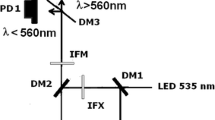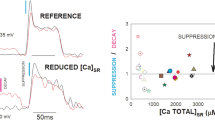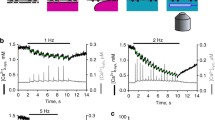Abstract
-
1.
A procedure has been developed to load Ca2+ reversibly by the sarcoplasmic reticulum (SR) of mechanically skinned muscle fibres from the toadBufo marinus under controlled conditions and was employed to investigate the effects of conditions known to reduce the K+ conductance located in the SR-membrane during Ca2+-loading on the amount of Ca2+ releasable by caffeine. 2. The amount of releasable Ca2+ was markedly increased compared to controls when 4-aminopyridine (4AP) (6 μM to 2 mM), tetraethylammonium (TEA), decamethonium (0.5 mM) or procaine (1 mM) were present in the Ca2+-loading solutions. All these substances are known to act as SR-K+-channel blockers. 3. The increased amount of releasable Ca2+ in the presence of the K+-channel blocker 4AP was observed both at low (0.3 mM) and at higher (1 mM) Mg2+ concentrations and was not affected by verapamil (20 μM), a known Ca2+-channel blocker of the sarcolemma nor by the Na+−K+ pump inhibitor, ouabain (1 mM). 4. In the presence of 0.1–5 μM ruthenium red, a known inhibitor of Ca2+ induced Ca2+ release from the SR, the amount of releasable Ca2+ was greatly increased by up to 300%. Addition of between 50 μM and 1.6 mM 4AP to ruthenium red Ca2+ loading solution modified differently the amount of releasable Ca2+, suggesting that the mechanism of action of 4AP is different from that of ruthenium red. 5. When all K+ ions in the loading solution were replaced by the less permeant Na+ ions the amount of releasable Ca2+ ions was also increased. 6. These results indicate that the amount of releasable Ca2+ from the SR is consistently modified under conditions aimed at interfering with the state of SR-K+-channels, suggesting that SR-K+-channels may play an important physiological role in the modulation of excitation-contraction coupling. One possible mechanism involving SR-K+-channels which could explain our results is discussed.
Similar content being viewed by others
References
Alvarez-Leefmans FJ, Gamino SM, Giraldez F, Gonzalez-Serratos H (1985) Intracellular free magnesium in frog skeletal muscle fibers measured with ion-selective microelectrodes. Biophys J 47:458a
Ashley CC, Moisescu DG (1977) Effect of changing the composition of the bathing solutions upon the isometric tension-pCa relationship in bundles of crustacean myofibrils. J Physiol 270:627–652
Baylor SM, Chandler WK, Marshall MW (1982) Optical measurements of intracellular pH and magnesium in frog skeletal muscle fibres. J Physiol 331:105–137
Coronado R, Miller C (1980) Decamethonium and hexamethonium block K+ channels of sarcoplasmic reticulum. Nature 288: 495–497
Coronado R, Miller C (1982) Conduction and block by organic cations in a K+-selective channel from sarcoplasmic reticulum incorporated into planar phospholipid bilayers. J Gen Physiol 79:529–547
Coronado R, Rosenberg RI, Miller C (1980) Ionic selectivity, saturation and block in a K+-selective channel from sarcoplasmic reticulum. J Gen Physiol 76:425–446
De Meis L (1981) In: Bittar EE (ed) The sarcoplasmic reticulum 2. Transport and energy transduction. John Wiley and Sons, New York
Donaldson SK (1985) Peeled mammalian skeletal muscle fibers. Possible stimulation of Ca2+ release via a transverse tubulesarcoplasmic reticulum mechanism. J Gen Physiol 86:501–527
Endo M (1977) Calcium release from the sarcoplasmic reticulum. Physiol Rev 57:71–108
Endo M, Tanaka M, Ogawa Y (1970) Calcium-induced release of calcium from the sarcoplasmic reticulum of skinned skeletal muscle fibres. Nature 228:34–36
Fabiato A, Fabiato F (1975) Contractions induced by a calcium triggered release of calcium from the sarcoplasmic reticulum of single skinned cardiac cells. J Physiol 249:469–497
Fink R, Wettwer E (1978) Modified K-channel gating by exhaustion and the block by internally applied TEA+ and 4-aminopyridine in muscle. Pflügers Arch 374:289–292
Fink RHA, Stephenson DG (1984) Blocking of K+ channels in SR-membranes can increase net Ca2+ loading. Biophys J 45:318a
Fink RHA, Stephenson DG (1986) Effects of ruthenium red (RR) on calcium movements across sarcoplasmic reticulum (SR) membranes on skinned muscle fibres. Proc Int Union Physiol Sci 16:267
Fink RHA, Stephenson DG, Williams DA (1986a) Potassium and ionic strength effects on isometric force of skinned twitch muscle fibres of rat and toad. J Physiol 370:317–337
Fink RHA, Stephenson DG, Williams DA (1986b) Calcium and strontium activation of single skinned muscle fibres of normal and dystrophic mice. J Physiol 373:513–525
Hess P, Weingart R (1981) Free magnesium in cardiac and skeletal muscle measured with ion-selective micro-electrodes. J Physiol 318:14–15P
Labarca B, Coronado R, Miller C (1980) Thermodynamic and kinetic studies of the gating behaviour of K-selective channel from the sarcoplasmic reticulum membrane. J Gen Physiol 76:397–424
Lea TJ, Ashley CC (1978) Increase in free Ca2+ in muscle after exposure to CO2. Nature 275:236–238
Lyster DJ, Fink RHA, Stephenson DG (1985) Effects of 4-aminopyridine on twitch responses and calcium transients in skeletal muscle. Proc Aust Physiol Pharmacol Soc 16:1842
Maughan D (1983) Diffusible magnesium in frog skeletal muscle cells. Biophys J 43:75–80
McKinley D, Meissner G (1978) Evidence for a K+, Na+ permeable channel in sarcoplasmic reticulum. J Membr Biol 44:159–186
Miledi R, Parker I, Zhu PH (1984) Extracellular ions and excitation-contraction coupling in frog twitch muscle fibres. J Physiol 351:687–710
Miller C (1978) Voltage-gated cation conductance channel from fragmented sarcoplasmic reticulum: steady state electrical properties. J Membr Biol 40:1–23
Miller C (1983) Integral membrane channels: studies in model membranes. Physiol Rev 63:1209–1242
Moisescu DG (1976) Kinetics of reaction in Ca-activated skinned muscle fibres. Nature 262:610–613
Moisescu DG, Thieleczek R (1978) Calcium and strontium concentration changes within skinned muscle preparations following a change in the external bathing solution. J Physiol 275:241–262
Montgomery RAP, Tomlins B, Williams AJ (1983) Single-channel activity of cardiac sarcoplasmic reticulum monitored in planar lipid bilayers in the rabbit. J Physiol 343:61 P
Oetliker H (1982) An appraisal of the evidence for a sarcoplasmic reticulum membrane potential and its relation to calcium release in skeletal muscle. J Muscle Res Cell Motil 3:247–272
Reuter H (1983) Calcium channel modulation by neurotransmitters, enzymes and drugs. Nature 301:569–574
Somlyo AV, Gonzales-Serratos H, Shuman H, McClellan G, Somlyo AP (1981) Calcium release and ionic changes in the sarcoplasmic reticulum of tetanized muscle: an electron probe study. J Cell Biol 90:577–594
Stanfield PR (1983) Tetraethylammonium ions and potassium permeability of excitable cells. Rev Physiol Biochem Pharmacol 97:1–67
Stefani E, Chiarandini DJ (1982) Ionic channels in skeletal muscle. Annu Rev Physiol 44:357–372
Stephenson DG, Williams DA (1981) Calcium-activated force responses in fast- and slow-twitch skinned muscle fibres of the rat at different temperatures. J Physiol 317:281–302
Stephenson EW (1981) Ca2+ dependence of stimulated45Ca efflux in skinned muscle fibres. J Gen Physiol 77:419–443
Thieleczek R (1982) Untersuchungen an der Skelettmuskelfaser des Frosches zur Aktivierbarkeit des kontraktilen Systems und zur Ca2+-Freisetzung und-Aufnahme des sarcoplasmatischen Reticulums. Ph.D. Thesis. Ruhr-University Bochum
Volpe P, Palade P, Costello B, Mitchell RD, Fleischer S (1983) Spontaneous calcium release from sarcoplasmic reticulum. Effect of local anesthetics. J Biol Chem 258:12434–12442
Volpe P, Salviati G, Chu A (1986) Calcium-gated calcium channels in sarcoplasmic reticulum of rabbit skinned skeletal muscle fibers. J Gen Physiol 87:289–304
Author information
Authors and Affiliations
Rights and permissions
About this article
Cite this article
Fink, R.H.A., Stephenson, D.G. Ca2+-movements in muscle modulated by the state of K+-channels in the sarcoplasmic reticulum membranes. Pflugers Arch. 409, 374–380 (1987). https://doi.org/10.1007/BF00583791
Received:
Accepted:
Issue Date:
DOI: https://doi.org/10.1007/BF00583791




